Interference Induced Enhancement of Magneto-Optical Effect in Pt/TbCo Hetero-Structured Films
Abstract
1. Introduction
2. Materials and Methods
3. Results
4. Discussion
5. Conclusions
Author Contributions
Funding
Conflicts of Interest
References
- Zhang, S. Spin hall effect in the presence of spin diffusion. Phys. Rev. Lett. 2000, 85, 393–396. [Google Scholar] [CrossRef] [PubMed]
- Liu, L.; Pai, C.-F.; Li, Y.; Tseng, H.W.; Ralph, D.C.; Buhrman, R.A. Spin-torque switching with the giant spin hall effect of tantalum. Science 2012, 336, 555–558. [Google Scholar] [CrossRef] [PubMed]
- Bang, D.; Awano, H. Reversal of domain wall motion in perpendicularly magnetized TbFeCo-based wires: Size dependence. Jpn. J. Appl. Phys. 2013, 52, 123001. [Google Scholar] [CrossRef]
- Haney, P.M.; Lee, H.-W.; Lee, K.-J.; Manchon, A.; Stiles, M.D. Current-induced torques and interfacial spin-orbit coupling. Phys. Rev. B 2013, 88, 214417. [Google Scholar] [CrossRef]
- Qiu, X.; Deorani, P.; Narayanapillai, K.; Lee, K.-S.; Lee, K.-J.; Lee, H.-W.; Yang, H. Angular and temperature dependence of current induced spin-orbit effective fields in Ta/CoFeB/MgO nanowires. Sci. Rep. 2014, 4, 4491. [Google Scholar] [CrossRef] [PubMed]
- Bychkov, Y.A.; Rashba, E.I. Properties of a 2D electron gas with lifted spectral degeneracy. JETP Lett. 1984, 39, 78–81. [Google Scholar]
- Dedkov, Y.S.; Fonin, M.; Rüdiger, U.; Laubschat, C. Rashba effect in the Graphene/Ni(111) System. Phys. Rev. Lett. 2008, 100, 107602. [Google Scholar] [CrossRef] [PubMed]
- Caviglia, A.D.; Gabay, M.; Gariglio, S.; Reyren, N.; Cancellieri, C.; Triscone, J.-M. Tunable rashba spin-orbit interaction at oxide interfaces. Phys. Rev. Lett. 2010, 104, 126803. [Google Scholar] [CrossRef] [PubMed]
- Argyres, P.N. Theory of the faraday and kerr effects in ferromagnetics. Phys. Rev. 1955, 97, 334–345. [Google Scholar] [CrossRef]
- Suzuki, Y.; Katayama, T.; Yoshida, S.; Tanaka, K.; Sato, K. New magneto-optical transition in ultrathin Fe(100) films. Phys. Rev. Lett. 1992, 68, 3355–3358. [Google Scholar] [CrossRef] [PubMed]
- Kato, Y.K.; Myers, R.C.; Gossard, A.C.; Awschalom, D.D. Observation of the spin hall effect in semiconductors. Science 2004, 306, 1910–1913. [Google Scholar] [CrossRef] [PubMed]
- Demko, L.; Schober, G.A.H.; Kocsis, V.; Bahramy, M.S.; Murakawa, H.; Lee, J.S.; Kezsmarki, I.; Arita, R.; Nagaosa, N.; Tokura, Y. Enhanced infrared magneto-optical response of the nonmagnetic semiconductor BiTeI driven by bulk rashba splitting. Phys. Rev. Lett. 2012, 109, 167401. [Google Scholar] [CrossRef] [PubMed]
- Bang, D.; Awano, H. High efficiency of the spin-orbit torques induced domain wall motion in asymmetric interfacial multilayered Tb/Co wires. J. Appl. Phys. 2015, 117, 17D916. [Google Scholar] [CrossRef]
- Khvalkovskiy, A.V.; Cros, V.; Apalkov, D.; Nikitin, V.; Krounbi, M.; Zvezdin, K.A.; Anane, A.; Grollier, J.; Fert, A. Matching domain-wall configuration and spin-orbit torques for efficient domain-wall motion. Phys. Rev. B 2013, 87, 020402(R). [Google Scholar] [CrossRef]
- Ryu, K.-S.; Thomas, L.; Yang, S.-H.; Parkin, S. Chiral spin torque at magnetic domain walls. Nat. Nanotechnol. 2013, 8, 527–533. [Google Scholar] [CrossRef] [PubMed]
- Boulle, O.; Rohart, S.; Buda-Prejbeanu, L.D.; Jué, E.; Miron, I.M.; Pizzini, S.; Vogel, J.; Gaudin, G.; Thiaville, A. Domain wall tilting in the presence of the dzyaloshinskii-moriya interaction in Out-of-plane magnetized magnetic nanotracks. Phys. Rev. Lett. 2013, 111, 217203. [Google Scholar] [CrossRef] [PubMed]
- Sumi, S.; Awano, H.; Hayashi, M. Interference induced enhancement of magneto-optical Kerr effect in ultrathin magnetic films. Sci. Rep. 2018, 8, 776. [Google Scholar] [CrossRef] [PubMed]
- Iemoto, S.; Sumi, S.; Awano, H.; Hayashi, M. Magneto-optical properties of Pt/TbCo heterostructure films. In Proceedings of the Abstruct of Intermag 2018 Conference, GW-16, Singapore, 23–27 April 2018; IEEE Magnetics Society: New Jersey, USA. [Google Scholar]
- Reigo, P.; Tomita, S.; Murakami, K.; Kodama, T.; Hosoito, N.; Yanagi, H.; Berber, A. Enhanced magneto-optical Kerr effects in Py/Ag/Bi trilayers. J. Phys. D Appl. Phys. 2017, 50, 19LT01. [Google Scholar] [CrossRef]
- Miron, I.M.; Gaudin, G.; Auffret, S.; Rodmacq, B.; Schuhl, A.; Pizzini, S.; Vogel, J.; Gambardella, P. Current-driven spin torque induced by the rashba effect in a ferromagnetic metal layer. Nat. Mater. 2010, 9, 230–234. [Google Scholar] [CrossRef] [PubMed]
- Torrejon, J.; Kim, J.; Sinha, J.; Mitani, S.; Hayashi, M.; Yamanouchi, M.; Ohno, H. Interface control of the magnetic chirality in CoFeB/MgO heterostructures with heavy-metal underlayers. Nat. Commun. 2014, 5, 4655. [Google Scholar] [CrossRef] [PubMed]
- Fan, X.; Celik, H.; Wu, J.; Ni, C.; Lee, K.-J.; Lorenz, V.O.; Xiao, J.Q. Quantifying interface and bulk contributions to spin-orbit torque in magnetic bilayers. Nat. Commun. 2014, 5, 3042. [Google Scholar] [CrossRef] [PubMed]
- Van’t Erve, O.M.J.; Hanbicki, A.T.; McCreary, K.M.; Li, C.H.; Jonker, B.T. Optical detection of spin hall effect in metals. Appl. Phys. Lett. 2014, 104, 172402. [Google Scholar] [CrossRef]
- Safeer, C.K.; Jué, E.; Lopez, A.; Buda-Prejbeanu, L.; Auffret, S.; Pizzini, S.; Boulle, O.; Miron, I.M.; Gaudin, G. Spin-orbit torque magnetization switching controlled by geometry. Nat. Nanotechnol. 2016, 11, 143–146. [Google Scholar] [CrossRef] [PubMed]
- Itoh, Y.; Suzuki, T. Magnetic and magneto-optical properties in TbFeCo/(Pt, Pd) multilayers. J. Appl. Phys. 2000, 87, 6902–6904. [Google Scholar] [CrossRef]
- Awano, H.; Niihara, T.; Ojima, M. Magneto-optical and magnetic properties of RE-TM/Pt multilayer films. J. Magn. Magn. Mater. 1993, 126, 550–552. [Google Scholar] [CrossRef]
- Van Drent, W.P.; Suzuki, T. Ultra-violet range magneto-optic study of FCC-Co and Co/Pt multilayers. J. Magn. Magn. Mater. 1997, 175, 53–62. [Google Scholar] [CrossRef]
- Egashira, K.; Yamada, T. Kerr-effect enhancement and improvement of readout characteristics in MnBi film memory. J. Appl. Phys. 1974, 45, 3643–3648. [Google Scholar] [CrossRef]
- Filmetrics Refractive Index Database. Available online: https://www.filmetrics.com/refractive-index-database (accessed on 26 July 2018).
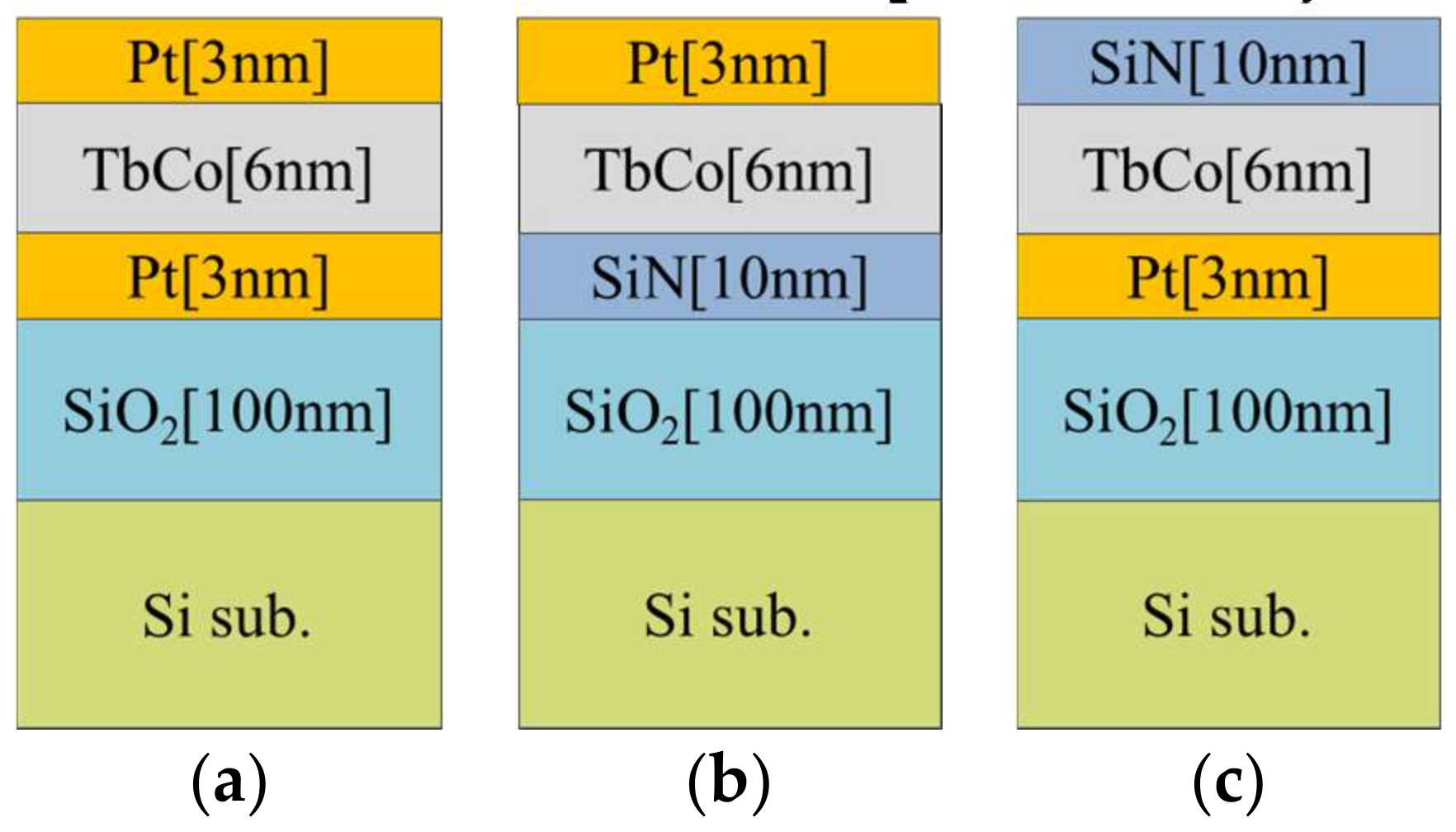
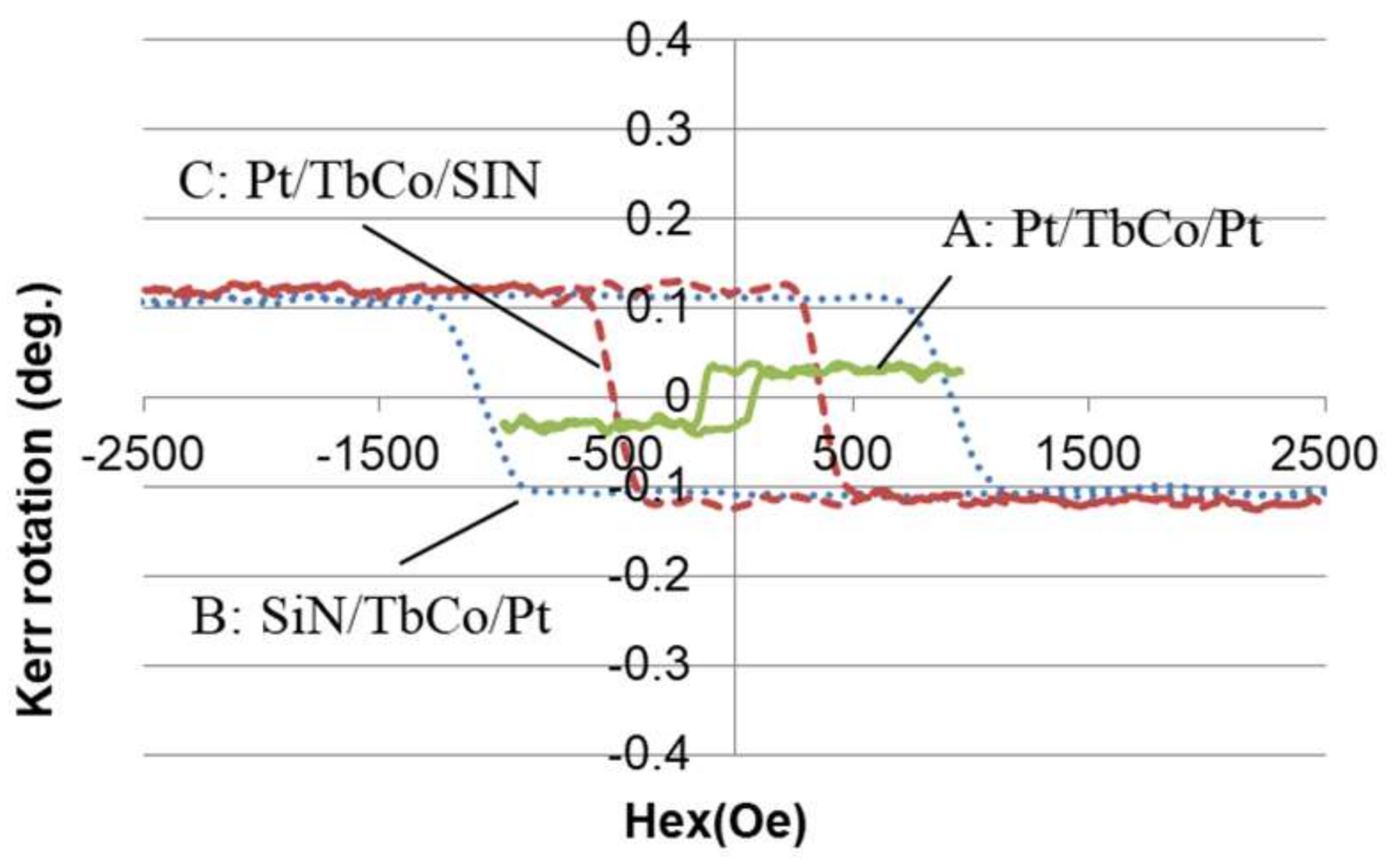
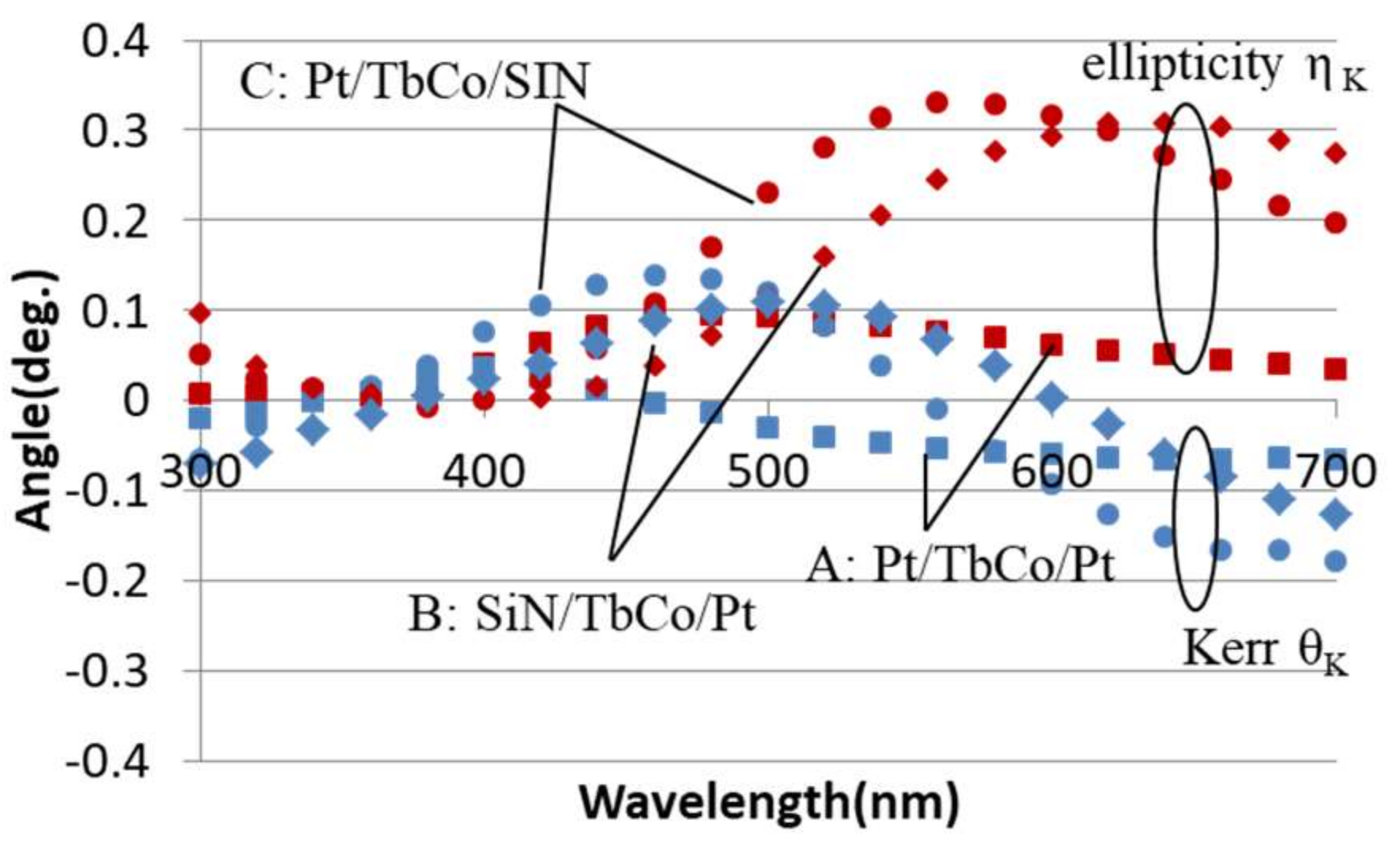

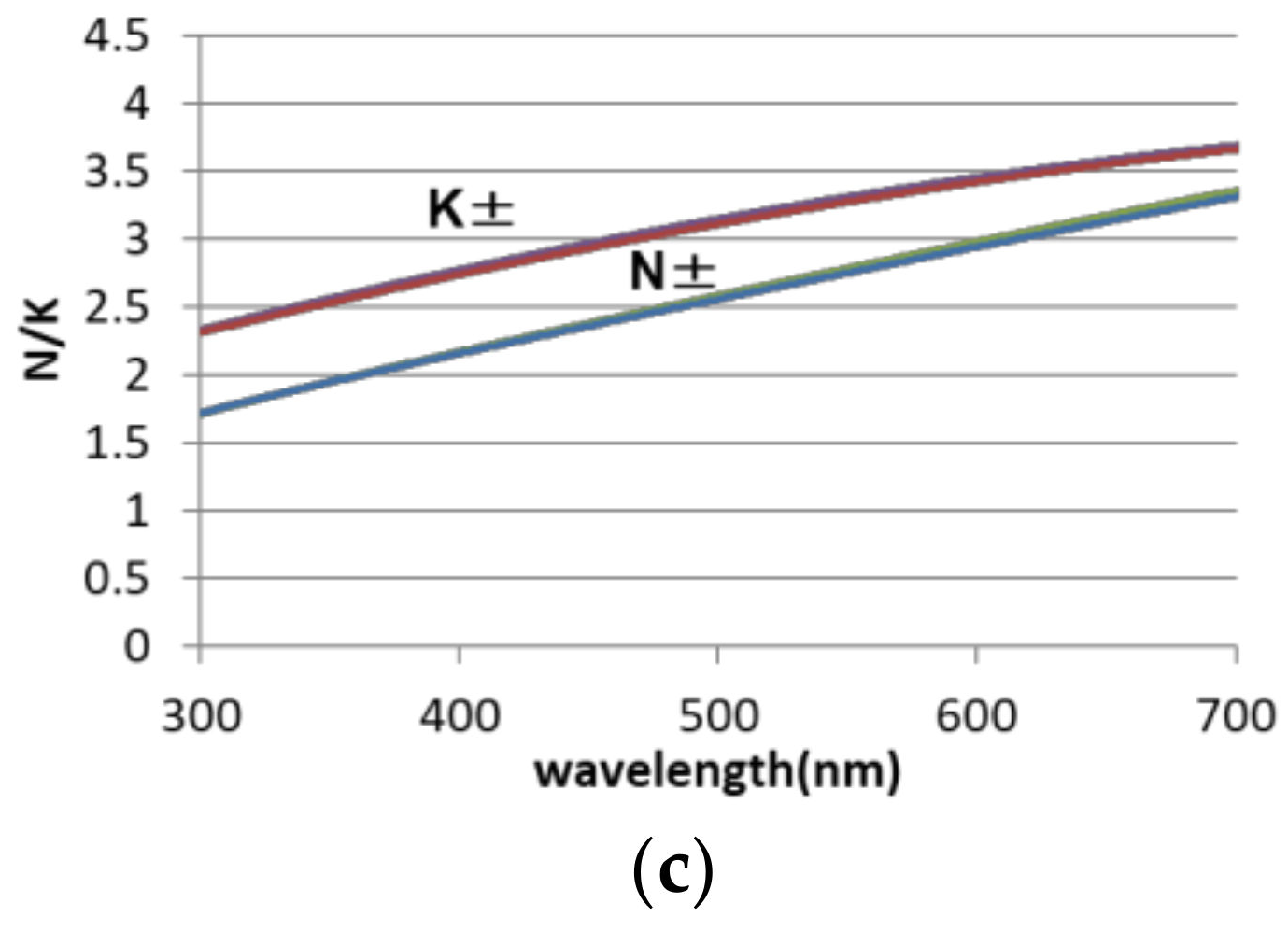
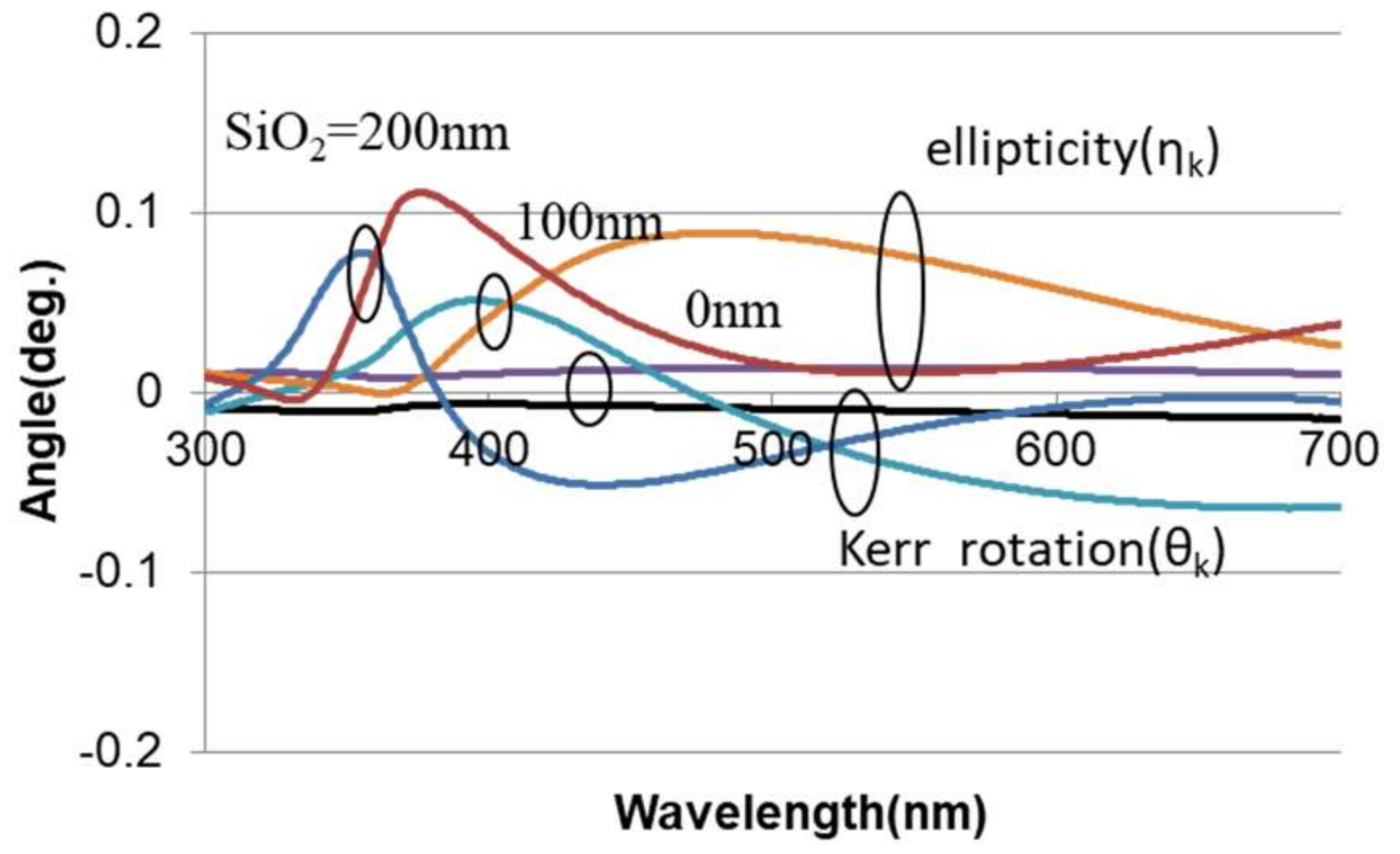
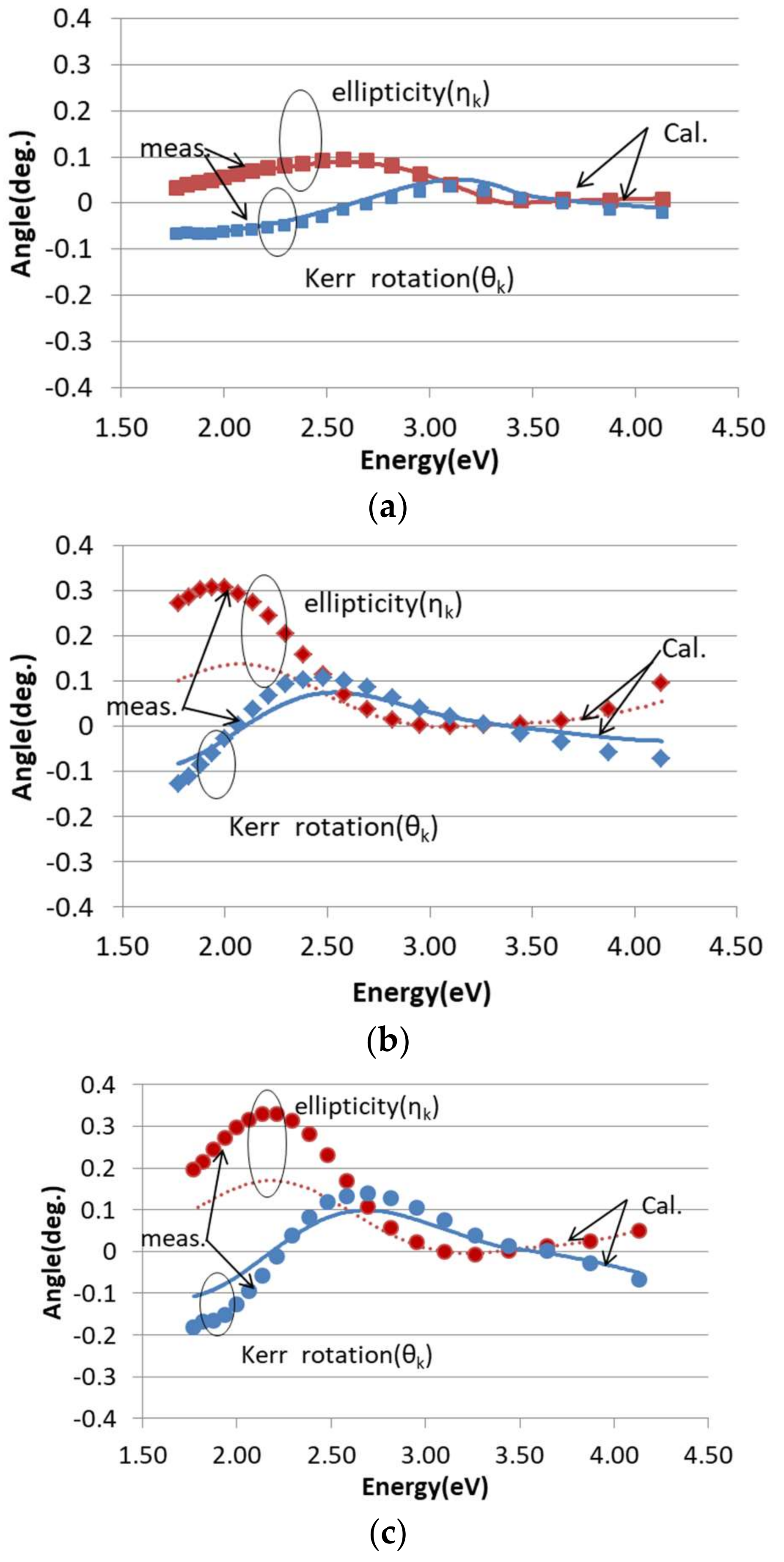
© 2018 by the authors. Licensee MDPI, Basel, Switzerland. This article is an open access article distributed under the terms and conditions of the Creative Commons Attribution (CC BY) license (http://creativecommons.org/licenses/by/4.0/).
Share and Cite
Iemoto, S.; Sumi, S.; Van Thach, P.; Awano, H.; Hayashi, M. Interference Induced Enhancement of Magneto-Optical Effect in Pt/TbCo Hetero-Structured Films. Crystals 2018, 8, 377. https://doi.org/10.3390/cryst8100377
Iemoto S, Sumi S, Van Thach P, Awano H, Hayashi M. Interference Induced Enhancement of Magneto-Optical Effect in Pt/TbCo Hetero-Structured Films. Crystals. 2018; 8(10):377. https://doi.org/10.3390/cryst8100377
Chicago/Turabian StyleIemoto, Syougo, Satoshi Sumi, Pham Van Thach, Hiroyuki Awano, and Masamitsu Hayashi. 2018. "Interference Induced Enhancement of Magneto-Optical Effect in Pt/TbCo Hetero-Structured Films" Crystals 8, no. 10: 377. https://doi.org/10.3390/cryst8100377
APA StyleIemoto, S., Sumi, S., Van Thach, P., Awano, H., & Hayashi, M. (2018). Interference Induced Enhancement of Magneto-Optical Effect in Pt/TbCo Hetero-Structured Films. Crystals, 8(10), 377. https://doi.org/10.3390/cryst8100377



